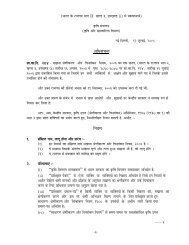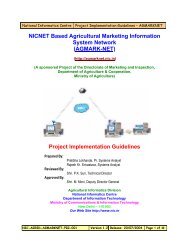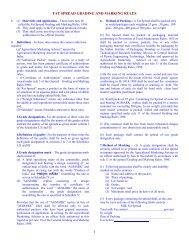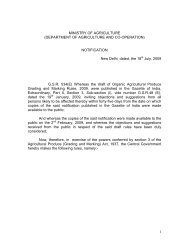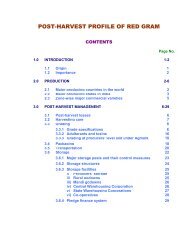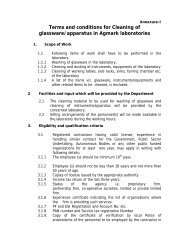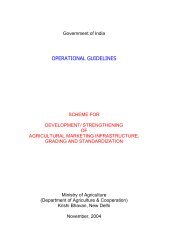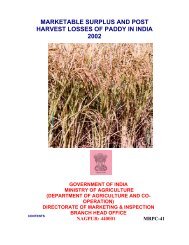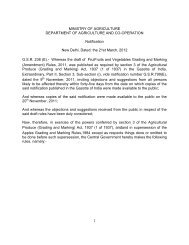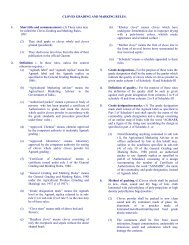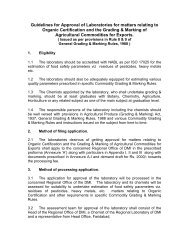Manual on good Agricultural Marketing practices for - Agmarknet
Manual on good Agricultural Marketing practices for - Agmarknet
Manual on good Agricultural Marketing practices for - Agmarknet
Create successful ePaper yourself
Turn your PDF publications into a flip-book with our unique Google optimized e-Paper software.
By precooling berry temperature is brought down to 4°C within six hours.<br />
In pre-cooling, temperature is maintained at 0-4 o C and Relative Humidity at<br />
90% and above.<br />
Grapes should be stored in cold storage (Temp.: 0 -2 o C and Relative<br />
Humidity: 90-95%).<br />
The harvested produce should be treated with sulphur dioxide to sterilize the<br />
fruits to prevent attack of bacteria and fungus.<br />
Use proper techniques while handling (loading and unloading).<br />
Grape guard should be used during storage and transportati<strong>on</strong> to retain<br />
freshness of fruits and checks fungal infecti<strong>on</strong>.<br />
4.0 GRADING<br />
Grading means the sorting of the homogenous lots of the produce according<br />
to the fixed grade standards. Produce is graded in accordance with the various<br />
quality factors.<br />
Grading is <strong>on</strong>e of the most important procedures to be followed in postharvest<br />
handling as it determines the quality, shelf life and price of the fruits.<br />
Bunches are graded based <strong>on</strong> the size and colour of berries and not <strong>on</strong> the shape of<br />
the bunch. Grading is d<strong>on</strong>e manually. While grading, the bunch should be held by<br />
the peduncle and care should be taken to avoid touching the berries/bunch by the<br />
naked palm of the hand.<br />
The <strong>Agricultural</strong> Produce (Grading and Marking) Act, 1937 was enacted to<br />
maintain the quality of agricultural produce in India. The Act authorizes the Central<br />
Government to frame rules related to the fixing of grade standards and the<br />
procedure to be adopted to grade the agricultural commodities included in the<br />
schedules. In accordance with this Act, specificati<strong>on</strong>s have been drawn up <strong>for</strong><br />
grapes c<strong>on</strong>sidering various quality factors. As per AGMARK, Extra, Class I and<br />
Class II grades are available based <strong>on</strong> bench weight.<br />
Benefits:<br />
1. Grading is beneficial to the farmers, traders as well as to the c<strong>on</strong>sumers.<br />
2. Grading of the grapes be<strong>for</strong>e sale enables farmers to get better price <strong>for</strong> their<br />
produce.




